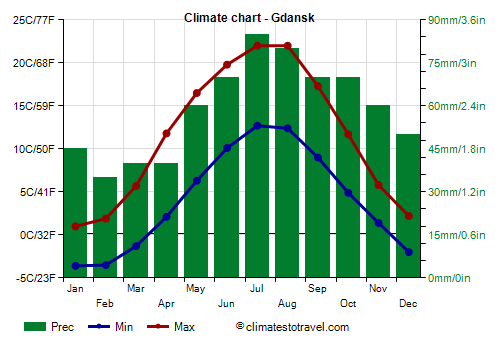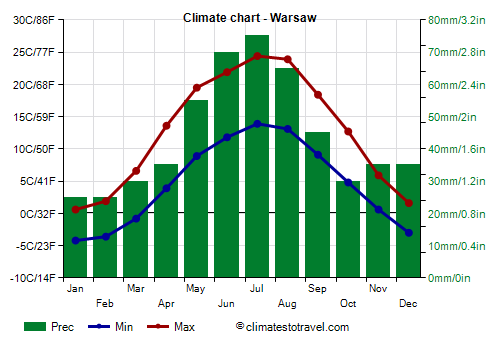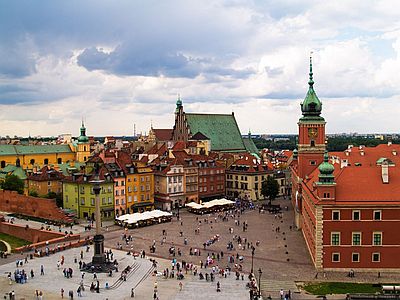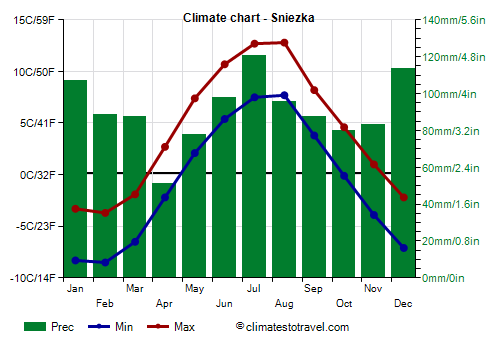In Poland, the climate is
continental, with very cold winters, often below freezing (0 °C or 32 °F), and warm summers. The climate is milder along the northern coast, overlooking the Baltic Sea, while it becomes progressively more continental going to the south, where the distance from the sea is greater.
Poland is an Eastern European country, extended from 49 to almost 55 degrees north latitude.
The country is largely flat, but in the south, on the border with Czechia and Slovakia, there are mountain ranges, the Sudetes and the Tatras (the latter are part of the Western Carpathians).
Precipitation is generally not abundant, since it amounts to 550/600 millimeters (21/26 inches) per year in most of the country, while it exceeds 1,000 mm (40 in) only in the mountainous areas.
The
sun in Poland is rarely seen from November to February, while in summer, also thanks to the length of the days, it shines for a good (though not exceptional) number of hours. Generally, in the lowlands there are 1,750 to 1,850 hours of sunshine per year.
The climate in detail
The seasons
Winter, from December to February, is cold and gray throughout the country.
The
average temperatures in January is around freezing along the Baltic coast, and progressively decreases towards the south and the east: it ranges from about 0.5 °C (33 °F) in the north-western area to -3 °C (26.5 °F) in the north-eastern areas, on the border with Belarus and Lithuania, while it's around -1 °C (30 °F) in the southern area. In Warsaw, the capital, located near the center of the country, the average in January is -1.5 °C (29.5 °F).
The ground is often covered with
snow for long periods, although snowfalls are generally not abundant.
However, the weather can have different characteristics:
usually, the sky is gray, the temperature is around freezing or a few degrees below, and a light snow falls. Sometimes, when the currents from the Atlantic are more intense, the temperature can rise above freezing, it can rain and the snow can melt.
On the other hand, when cold air masses from Russia reach the country, there may be
cold spells, during which the temperature decreases by
many degrees, and drops below -20 °C (-4 °F). The coldest records are around -27/-32 °C (-17/-25 °F) in the interior, and therefore in much of Poland, while they are around -20 °C (-4 °F) along the northern coast.
Spring, from March to May, is initially cold, so much so that in March it snows and freezes quite often, and in early April, there can still be late cold waves with snow showers. In April and early May, cold days alternate with the first warm days, while by mid-May, the temperature becomes pleasant in a more stable manner, with highs around 18/20 °C (64/68 °F) and sometimes above.
Summer, from June to August, is mild or pleasantly warm. The Baltic coast, which during winter was the mildest zone, becomes the coolest in summer: here, highs in July and August are around 22 °C (72 °F), while they gradually increase towards the south, reaching 25 °C (77 °F) in the center and south of the country.
Summer is the
rainiest season, because some Atlantic disturbances can pass even in this period, moreover, during the days of good weather,
thunderstorms can break out in the afternoon. The latter are more frequent in inland areas, and even more so near the Sudetes and Tatra Mountains, in the south.
In July, it rains on average for 10 days on the north coast, 11 days in the center-south and 12 days at the foot of the mountains in the south.
Sometimes,
very hot periods can occur, usually of short duration, during which the temperature can reach or exceed 35 °C (95 °F).
In
autumn, from September to November, the temperatures decrease rapidly, but the first half of September is still pleasant. Afterwards, the weather becomes cold and dull.
The coast
Gdansk

![]() Climate chart - Gdansk
Climate chart - Gdansk
In
Gdansk, located on the northern coast, the average temperature ranges from around -1.5 °C in January to 17.5 °C in July.
In Gdansk, precipitation amounts to 570 mm (22.5 in) per year; the rainiest period runs from June to August, while precipitation in winter is not abundant.
The Baltic Sea is very cool, if not cold, even in summer, however, the water temperature reaches 18 °C (64 °F) in August.
Inland areas
Warsaw

![]() Climate chart - Warsaw
Climate chart - Warsaw
As mentioned, the climate in inland areas is slightly more continental. In
Warsaw, the daily average in July is around 20 °C (68 °F).
Precipitation in Warsaw is not abundant, in fact, it amounts to about 550 mm (21.6 in) per year; the driest seasons are winter and spring, while the rainiest is summer.

Mountains
In southern Poland, where mountain ranges such as the Sudetes and the Tatras are found, the climate is naturally
colder. Winters are cold and snowy, but not much colder than in the lowlands (because of the temperature inversion, a phenomenon whereby cold air stagnates on the lowest layers of the atmosphere, which is typical of cold plains in winter). Summers are cool, with frequent afternoon thunderstorms.
In
Zakopane, a popular tourist resort, at 850 meters (2,800 ft) above sea level, the average temperature ranges from -3.5 °C (25.5 °F) in January to 16 °C (61 °F) in July. At higher altitudes, at 2,000 meters (6,500 feet) above sea level, it ranges from -8 °C (17.5 °F) in January to 9 °C (48 °F) in July.
On the slopes of these southern mountains and in the valleys, a
warm, dry wind, similar to the
Foehn can blow (the
Halny in the Tatras and the
Moazagotl in the Sudetes), especially in early spring and in autumn. Sometimes, this wind can be strong and cause damage.
The highest peak in the country is Mount
Rysy, 2,503 meters (8,212 feet) high, on the border with Slovakia.
Sniezka

![]() Climate chart - Sniezka
Climate chart - Sniezka
On Mount
Sniežka, the highest among the "Giant Mountains" (or
Karkonosze), located at 1,600 meters (5,300 ft) of altitude, in the southwest of the country, at the border with the Czech Republic, the average temperature ranges from around -6 °C (21 °F) in January to around 10 °C (50 °F) in July and August. Precipitation amounts to almost 1,100 mm (43 in) per year.
When to go
The best time to visit Poland is
summer, from June to August, however, you can generally go in the warm season, from mid-May to mid-September. The temperatures are usually cool at night and mild or pleasantly warm during the day.
However, keep in mind that there can be cool and rainy days, but also hot and sunny days.
In the mountains, it's still possible to
ski at Easter, while at Christmas, it can be very cold, and the days are short. In February, it's cold as well, but at least the days are a bit longer.
What to pack
In
winter: bring very warm clothes, a fleece, a down jacket, a hat, gloves, a scarf, and a raincoat or umbrella.
In
summer: bring light clothes, t-shirts, but also long pants, a jacket and a sweater for the evening or for cool days; a raincoat or umbrella.
Back to topSee also the
temperatures month by month